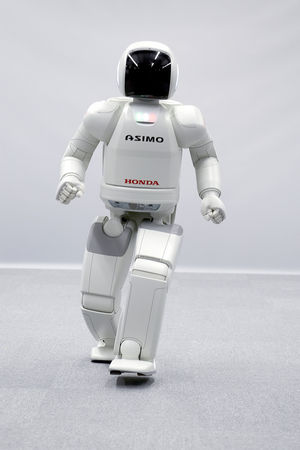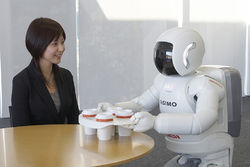CZ:Featured article/Current: Difference between revisions
imported>Chunbum Park |
imported>Chunbum Park No edit summary |
||
| Line 1: | Line 1: | ||
== '''[[ | == '''[[ASIMO]]''' == | ||
---- | ---- | ||
{{Image|The New ASIMO.jpg|right|300px|The New ASIMO introduced in 2005.}} | |||
'''ASIMO''' (アシモ ''ashimo'') is the world's most advanced [[humanoid]] robot, developed by the [[Japan]]ese company [[Honda]]. The first ASIMO was completed after 15 years of research, and it was officially unveiled on October 31, 2000. The robot resembles a small astronaut wearing a backpack, and is capable of performing a variety of tasks, including running, kicking a ball, walking up and down stairs, and recognizing people by their appearance and voice. The name is short for "'''A'''dvanced '''S'''tep in '''I'''nnovative '''MO'''bility" and is also known as an abbreviation of ''ashita no'' mobility, meaning 'mobility in the future.'<ref name="masatokenichi14">Masato, Hirose and Ogawa Kenichi, 2006. "Honda Humanoid Robots Development." pp. 14</ref> It was named in reference to [[Isaac Asimov]], an American professor and science fiction writer who is credited with coining the term ''robotics'' and proposing the [[Three Laws of Robotics]]. | |||
== Design concept == | |||
<blockquote>"Following in the steps of Honda motorcycles, cars and power products. Honda has taken up a new challenge in mobility - the development of a two-legged humanoid robot that can walk."<ref name="asimomain">"ASIMO Technology." ''Honda Worldwide''. Honda Motor Co.,Ltd. Web. 24 Aug. 2011. <http://world.honda.com/ASIMO/technology/>.</ref></blockquote> | |||
Bipedal movement has been the primary focus of Honda's humanoid robotic research to create general-purpose, intelligent robots that can "coexist and cooperate with [[humans]]",<ref name=" ">Pfeiffer, Friedrich, and Hirochika Inoue, 2007. "Walking: Technology and Biology." pp. 5</ref> since it began in 1986 with the development of the 'E0' prototype. While there existed many different visions of futuristic robots, such as R2-D2 and C-3PO from [[Star Wars]], it was recognized that human-like robots with bipedal mobility are the most ideal for operating and [[human-robot interaction|interacting with humans]] in human surroundings.<ref name="masatokenichi11">Masato, Hirose and Ogawa Kenichi, 2006. "Honda Humanoid Robots Development." pp. 11</ref> | |||
< | |||
The | Based on this concept, ASIMO's design concerns three main elements, which are human-friendliness, adaptability to the human environment, and engineering feasibility. The robot's height was set at 120 cm (or 130 cm in the case of second-generation ASIMO), which is similar to a child's, as this would be practical both on the engineering aspect (since a smaller and lighter robot is less challenging than an adult-sized robot such as the P2 prototype) and the question of operability in the environment, where light switches are normally located 110 cm from the floor. With less bulk, the robot would be able to move more efficiently in handling obstacles and narrow passages,<ref name="masatokenichi15">Masato, Hirose and Ogawa Kenichi, 2006. "Honda Humanoid Robots Development." pp. 15</ref> and it would also be less overwhelming presence to humans and, in case of accidents, less hazardous. | ||
{{Image|ASIMO reservation system.jpg|left|250px|The New ASIMO serving refreshments.}} | |||
Its humanoid form that is not only functionally but also proportionally similar to the [[human anatomy|human body]] was meant to enhance its human and environment-friendly qualities by allowing it to make gestures and communicate face-to-face, as well as using the stairs or taking seat in a car. Its strikingly minimalist appearance, which lacks a detailed face and toes on its feet, provides fewer moving parts as rooms for error, while being clearly discernible to humans as consisting of a head, torso, arms, hands, legs, and feet. ASIMO being a popular icon, its design has contributed to the conceptual diversity of futuristic robots, based on a very unique design language of modern Japanese aesthetics.<ref name="aestheticsmansfield">Mansfield, Stephen. "Japanese Aesthetics and High-Tech Design." Nov. 2001. ''J@pan Inc''. Japan Inc Communications, Inc. Web. 10 Oct. 2011. <http://www.japaninc.com/article.php?articleID=515>.</ref> | |||
Honda has suggested several future uses for robots like the ASIMO, which, despite its impressive list of feats and features, remains an experimental technology demonstrator that needs to operate in controlled, predictable environment. With further advances, ASIMO could be engaged in useful tasks such as elderly care assistance, [[firefighting]], and toxic cleanup.<ref name="asimotechguide18">"ASIMO Technical Guide". pp. 18</ref> At the present, the ASIMO is being leased to companies for receptionist work.<ref name="sakagamietal2478">Sakagami, et al, 2002. ''The Intelligent ASIMO: System Overview and Integration''. pp. 2478</ref> | |||
</ | |||
''[[ASIMO|.... (read more)]]'' | |||
''[[ | |||
{| class="wikitable collapsible collapsed" style="width: 90%; float: center; margin: 0.5em 1em 0.8em 0px;" | {| class="wikitable collapsible collapsed" style="width: 90%; float: center; margin: 0.5em 1em 0.8em 0px;" | ||
|- | |- | ||
! style="text-align: center;" | [[ | ! style="text-align: center;" | [[ASIMO#notes|notes]] | ||
|- | |- | ||
| | | | ||
{{reflist|2}} | {{reflist|2}} | ||
|} | |} | ||
Revision as of 01:03, 31 March 2012
ASIMO
ASIMO (アシモ ashimo) is the world's most advanced humanoid robot, developed by the Japanese company Honda. The first ASIMO was completed after 15 years of research, and it was officially unveiled on October 31, 2000. The robot resembles a small astronaut wearing a backpack, and is capable of performing a variety of tasks, including running, kicking a ball, walking up and down stairs, and recognizing people by their appearance and voice. The name is short for "Advanced Step in Innovative MObility" and is also known as an abbreviation of ashita no mobility, meaning 'mobility in the future.'[1] It was named in reference to Isaac Asimov, an American professor and science fiction writer who is credited with coining the term robotics and proposing the Three Laws of Robotics.
Design concept
"Following in the steps of Honda motorcycles, cars and power products. Honda has taken up a new challenge in mobility - the development of a two-legged humanoid robot that can walk."[2]
Bipedal movement has been the primary focus of Honda's humanoid robotic research to create general-purpose, intelligent robots that can "coexist and cooperate with humans",[3] since it began in 1986 with the development of the 'E0' prototype. While there existed many different visions of futuristic robots, such as R2-D2 and C-3PO from Star Wars, it was recognized that human-like robots with bipedal mobility are the most ideal for operating and interacting with humans in human surroundings.[4]
Based on this concept, ASIMO's design concerns three main elements, which are human-friendliness, adaptability to the human environment, and engineering feasibility. The robot's height was set at 120 cm (or 130 cm in the case of second-generation ASIMO), which is similar to a child's, as this would be practical both on the engineering aspect (since a smaller and lighter robot is less challenging than an adult-sized robot such as the P2 prototype) and the question of operability in the environment, where light switches are normally located 110 cm from the floor. With less bulk, the robot would be able to move more efficiently in handling obstacles and narrow passages,[5] and it would also be less overwhelming presence to humans and, in case of accidents, less hazardous.
Its humanoid form that is not only functionally but also proportionally similar to the human body was meant to enhance its human and environment-friendly qualities by allowing it to make gestures and communicate face-to-face, as well as using the stairs or taking seat in a car. Its strikingly minimalist appearance, which lacks a detailed face and toes on its feet, provides fewer moving parts as rooms for error, while being clearly discernible to humans as consisting of a head, torso, arms, hands, legs, and feet. ASIMO being a popular icon, its design has contributed to the conceptual diversity of futuristic robots, based on a very unique design language of modern Japanese aesthetics.[6]
Honda has suggested several future uses for robots like the ASIMO, which, despite its impressive list of feats and features, remains an experimental technology demonstrator that needs to operate in controlled, predictable environment. With further advances, ASIMO could be engaged in useful tasks such as elderly care assistance, firefighting, and toxic cleanup.[7] At the present, the ASIMO is being leased to companies for receptionist work.[8]
| notes |
|---|
|

